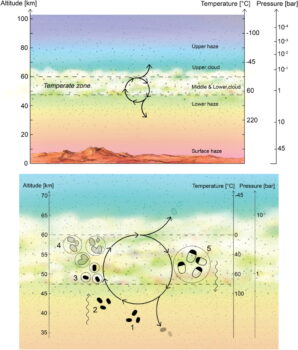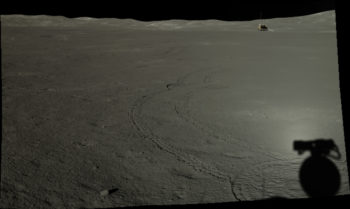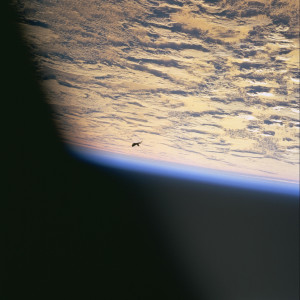Archive for August, 2020
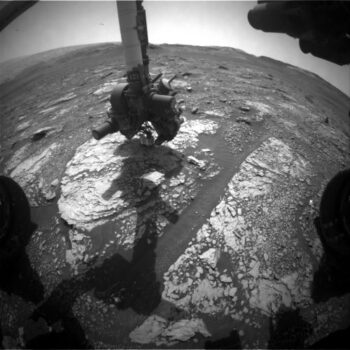
Curiosity Front Hazard Avoidance Camera Right B image acquired on Sol 2868, August 30, 2020.
Credit: NASA/JPL-Caltech
NASA’s Curiosity Mars rover is now performing Sol 2869 duties.
“Curiosity has been in the area of the ‘Mary Anning’ targets for a while now, and that’s for a very good reason,” reports Susanne Schwenzer, a planetary geologist at The Open University, Milton Keynes, United Kingdom. The rover came to find the ideal rocks for a very special experiment using the Sample Analysis at Mars (SAM) Instrument Suite.

The Sample Analysis at Mars tool is called SAM. SAM is made up of three different instruments that search for and measure organic chemicals and light elements that are important ingredients potentially associated with life.
Credit: Credit: NASA/JPL-Caltech

The Sample Analysis at Mars (SAM) instrument, at NASA’s Goddard Space Flight Center, Greenbelt, Md., will analyze samples of material collected by the rover’s arm.
Credit: NASA-GSFC
“First, we confirmed we had the rock-type we desired. Appearance can always deceive (and yes, that’s not just for rocks, we all know that!),” Schwenzer adds. Chemistry, however, doesn’t lie, and the robot’s Chemistry and Camera (ChemCam) and its Alpha Particle X-Ray Spectrometer (APXS) have confirmed that what’s under the drill is what scientist’s came for.
Ready to go
“SAM has confirmed that all procedures are now ready to go. Thus, the big headline today is: We are ‘go’ for drilling the “Mary Anning 3” target,” Schwenzer says, and to perform the SAM wet chemistry experiment later this week.
“As it’s [a] well-tested routine for our drill sequence by now, the first thing to do after the drilling is to image the drill hole. ChemCam will perform a passive spectral investigation, and Mastcam will do a multispectral measurement on the drill fines. While at it, Mastcam also takes a small 5×1 mosaic of the nearby target “Upper Ollach” again. We are taking advantage of the fact that – for the drilling – we are in the same place for several sols in a row,” Schwenzer adds.

Curiosity Mars Hand Lens Imager photo produced on Sol 2867, August 30, 2020.
Credit: NASA/JPL-Caltech/MSSS
Wind regime
Using repeated imaging of this target, scientists can detect changes that occur over time, and this way judge the current wind regime. Dust devils are one way to watch out for wind, looking at how grains shift over time is another.
“While we are here,” Schwenzer continues, “we are of course also looking for all the small features we can spot in our surroundings. Tiny dark layers in a nearby target ‘Ayton’ caught our eye a few sols ago and were investigated by ChemCam,”

Curiosity Mars Hand Lens Imager photo produced on Sol 2867, August 30, 2020.
Credit: NASA/JPL-Caltech/MSSS
The robot’s Mars Hand Lens Imager (MAHLI) is looking at them this sol. “We are also investigating their chemistry further, as ChemCam will add more measurements on those features to improve measurement statistics and thus understand better what the dark nodular features are made of,” Schwenzer points out.
Will looks deceive?
ChemCam targets for that are “Toab” and another raster on the Ayton block. ChemCam is also looking at the target “Sartle,” Schwenzer says, which has a bit more greyish appearance and some white material – suspected calcium sulfate, at least if it is what it looks like. “Let’s see, if looks deceive – or not!”

Target “Ayton” as seen by the rover’s Chemistry & Camera Remote Micro Imager (RMI). Photo taken on Sol 2867, August 29, 2020.
Credit: NASA/JPL-Caltech/LANL
In other parts of the plan, the rover’s Dynamic Albedo of Neutrons (DAN) is doing a DAN passive, and environmental researchers continue to observe the current atmospheric situation with dust opacity and dust devil observations.
Mastcam is also adding to the mosaic they are building over the past sols with a 14×3 mosaic.
“All the things one can do while drilling, and that are very exciting for science to analyze a wider area for relationships of the observed structures and textures,” Schwenzer concludes, “but the big nail-biting moment will be when we learn if the wet chemistry experiment was successful. Fingers crossed for SAM!”
Explore Mars, Inc. has issued its annual report — The Humans to Mars Report (H2MR) — presenting a snapshot of current progress in mission architectures, science, domestic and international policy, human factors, STEAM Education, and public perception regarding human missions to Mars.
The document highlights progress and challenges from year to year.
“The momentum that has been building for many years to send humans to Mars in the 2030s has continued unabated, and indeed grown, during the past year,” the report explains. “The decade of the 2020s is now upon us, and we can now truly say that instead of Mars being two decades away, it is now achievable in the next decade.”

NASA’s robotic Holy Grail mission, a Mars sample return effort to bring back to Earth Martian collectibles.
Credit: NASA/JPL-Caltech
Findings and observations
The report contains a number of “findings and observations.” Among them:
— Stronger collaboration between NASA mission directorates will help assure that the science missions of the 2020s maximize both scientific goals as well as advance human exploration in the 2030s.
— Implementing next-generation orbiters and surface missions in the near future to prospect for resources (notably water ice) will reduce the overall cost of missions to Mars while providing significant science gains.
— A Mars Sample Return project would not only achieve revolutionary science, but would also allow scientists to assess the material characteristics of martian dust and its potential toxicity to human explorers, as well as to develop appropriate planetary-protection measures.

China’s three-in-one mission: An orbiter, lander, and rover.
Credit: Wan, W.X., Wang, C., Li, C.L. et al.
— Multiple additional year-long missions on the International Space Station with diverse populations in low Earth orbit that evolve to the duration of human Mars missions will be required. Consider sending astronauts directly from the ISS to Mars analogs to investigate how self-guided recovery impacts both health and productivity with realistic communications delay.
— As lunar activities are developed, such plans should be constructed in a manner that should feed forward to and therefore advance the goal of human missions to Mars in the 2030s and should not hinder achieving that goal.
— As long as valid security concerns by the United States and its international partners are sufficiently addressed, the role of China in future international efforts to reach Mars should be considered by Congressional and Administration policy makers.
To read the full report, go to:
https://www.exploremars.org/wp-content/uploads/2020/08/H2MR_2020_Web_v1.pdf
Also, go to the group’s virtual conference this week, starting today, at:
In Pursuit of the Moon – The Hunt for a Major NASA Contract by Bill Townsend; iUniverse – a self-publishing imprint; 168 pages; 2019; Softcover; $13.99.
This is a tell-all story that’s rarely told. The author takes the reader deep inside the inner-workings of a real-life aerospace industry pursuit – vying for the ARES I Instrument Unit Avionics contract, released by NASA in 2007. Ares I was the crew launch vehicle that was being developed at the time by NASA as part of the Constellation program, a precursor to today’s Artemis adventure.
After forty-plus years with NASA, the author details his joining of Ball Aerospace in Boulder, Colorado, in 2004, then taking thirty-five top-notch “Birkenstock-wearing engineers” to Huntsville, Alabama, to establish a new Ball Aerospace office designed to champion the chase for the contract. The competition was stiff – an entrenched cabal of aerospace contractors who had dominated NASA’s human space flight program for decades.
You can get a sense of the astronautical angst a person can go through just by noting the titles of this six-part book: “The Situation,” “Before the Storm,” “The Proposal,” “The Down Select,” “The Decision,” and “The Aftermath.”
“So, with the benefit of perfect hindsight,” what did we do well, and what could we have done better?,” Townsend writes.
This is an intimate look at how to work with a major government agency, NASA, and how the space agency behaves and conducts itself with its contractor base…sometimes in ways you would not anticipate.
For those not familiar with the aerospace industry, the author’s intent is to pry your eyes open to what really goes on. And for those in the aerospace industry, “perhaps there is a thing or two that you can learn from my telling of this story,” Townsend explains. Moreover, for those within NASA, he has some select words too!
Townsend has spent more than fifty years in the aerospace industry, a distinguished career with particular expertise in the management of major space flight programs. His reflections about the people, the places, and the paperwork makes it a worthy read for all those out there trying to shape a vibrant, yet-affordable space program for today.
For more information on this book, go to:
https://www.iuniverse.com/en/bookstore/bookdetails/794782-in-pursuit-of-the-moon

The Zimmerwald Laser and Astrometry Telescope (ZIMLAT) in Zimmerwald, which is used for distance measurement to space debris objects.
Credit: University of Bern, AIUB
Possible collisions between orbital debris and satellites can be detected at an early stage and evasive maneuvers can be initiated – that’s the promise of a new ability to spot space clutter during the day.
According to researchers at the University of Bern’s Zimmerwald Observatory they are the first in the world to succeed in determining the distance to a space debris object using a geodetic laser in daylight.
Geodetic laser systems are at least one order of magnitude less powerful than highly specialized space debris lasers.
The orbits of disused satellites, rocket upper stages or fragments of collisions and explosions are not known with sufficient accuracy, i.e. only to a few hundred meters.
The measurement of distances to such objects using the satellite laser ranging method is an effective technology to improve the trajectory accuracy to a few meters, say university specialists.

Example of a “string of pearls” of photons reflected by the target debris object in the “sea of sky background photos.”
Credit: University of Bern, AIUB
Reflected photons
“We have been using the technology at the Zimmerwald Observatory for years to measure objects equipped with special laser retroreflectors. Only a few observatories worldwide have succeeded in determining distances to space debris using special, powerful lasers to date,” explains Thomas Schildknecht, head of the Zimmerwald Observatory and deputy director of the Astronomical Institute at the University of Bern. “These measurements were also previously only possible at night,” he adds.
The success at Zimmerwald Observatory was made possible using a combination of active tracking of the debris using a highly sensitive scientific CMOS (short for complementary metal-oxide-semiconductor) camera with real-time image processing and a real-time digital filter to detect the photons reflected by the object.
Schildknecht told Inside Outer Space that the observation was an abandoned launcher upper stage. “Pretty large, of the order of [26 feet] 8 meters long. Precise orbits of such large objects are particularly important to avoid catastrophic collisions (laser ranging allows for higher accuracy orbits than, e.g., radars).”
During night time objects with sizes of the order of 1 meter have been tracked with lasers, Schildknecht says.

Thomas Schildknecht of the Astronomisches Institut der Universität Bern (AIUB).
Credit: Manu Friederich
Network of stations
In 2018, two additional domes extended the observatory ultimately making it the world’s largest observation station for space debris.
“The possibility of observing during the day allows for the number of measures to be multiplied. There is a whole network of stations with geodetic lasers, which could in future help build up a highly precise space debris orbit catalog,” Schildknecht points out. “More accurate orbits will be essential in [the] future to avoid collisions and improve safety and sustainability in space.”

A composite image of the planet Venus as seen by the Japanese probe Akatsuki. The clouds of Venus could have environmental conditions conducive to microbial life.
Credit: JAXA
The clouds of Venus may be a depot for life.
New research has looked into the prospect that microbial life could reside inside protective cloud droplets (sulfuric acid mixed with water) hovering high above that hellish world.
The new work is led by Sara Seager in the Department of Earth, Atmospheric, and Planetary Sciences at the Massachusetts Institute of Technology and published in the journal, Astrobiology.
Challenges
The scientific team reassessed the severe and unique environmental challenges that life in the aerial biosphere of Venus would have to overcome. “The challenges include: an extremely acidic environment, far more so than any known environment on Earth; very low water content; and nutrient scarcity,” they write.
The main new point of the work is to present a life cycle concept – albeit hypothetical.
Leaky depot
“Assuming that life must reside inside cloud droplets,” the researchers report, “we resolve the subsequent conundrum of gravitationally settling droplets reaching hotter, uninhabitable regions by proposing a Venusian life cycle where a critical step is microbes drying out to become spores on reaching the relatively stagnant lower haze layer, which we call a leaky ‘‘depot.’’ The dried out spores would reside there until some of them can be transported back up to the temperate, habitable cloud layers, where they would act as CCN [cloud condensation nuclei are ‘‘cloud seeds,’’ a small solid surface needed for vapor to condense] to promote cloud formation, becoming enveloped in cloud droplets to continue the life cycle.”
“We argue that life, if it exists in Venus’ atmosphere, must reside inside cloud liquid droplets for the majority of its life cycle,” the scientists report.
Go to the paper — “The Venusian Lower Atmosphere Haze as a Depot for Desiccated Microbial Life: A Proposed Life Cycle for Persistence of the Venusian Aerial Biosphere” – at:

Curiosity Right B Navigation Camera image acquired on Sol 2864, August 26, 2020.
Credit: NASA/JPL-Caltech
NASA’s Curiosity Mars rover is now carrying out Sol 2865 duties.
“Mars is often a very dynamic place due to its atmosphere and how it interacts with the surface,” explains Claire Newman, Atmospheric Scientist at Aeolis Research in Pasadena, California. “At present, we’re in the “windy season” in Gale crater.”

Curiosity Front Hazard Avoidance Camera Left B image taken on Sol 2864, August 26, 2020.
Credit: NASA/JPL-Caltech
This means, continues Newman, “that we’re seeing increased aeolian (meaning “related to the wind”) activity at the surface. In recent sols, we’ve taken Mastcam images of the same surface ripples on multiple sols. We’ve been able to see the ripples moving from sol to sol, due to wind moving the sand grains that make up the ripples, which tells us both the dominant wind direction and how strong the wind is.”

Curiosity Mars Hand Lens Imager (MAHLI) photo produced on Sol 2864, August 26, 2020.
Credit: NASA/JPL-Caltech/MSSS
Surface, rover deck changes
A recent plan scripted for Curiosity included more observations designed to look for changes on the surface and rover deck: a Mars Descent Imager (MARDI) image of the region below the rover, to prepare for making more images of that location over the next few sols so Mars researchers can look for changes, and a Navcam deck pan, to look for changes to dust and sand grains on the rover deck.

Look closely! On Sol 2847, Curiosity captured a dust devil that was so impressive that you can just see it moving to the right, at the border between the darker and lighter slopes. Give up? Go to this video at: https://mars.nasa.gov/internal_resources/929/
Credit NASA/JPL-Caltech
“It’s almost summer in Gale crater, which puts us in a period of strong surface heating that lasts from early spring through mid-summer,” Newman adds. “Stronger surface heating tends to produce stronger convection and convective vortices, which consist of fast winds whipping around low pressure cores. If those vortices are strong enough, they can raise dust from the surface and become visible as “dust devils” that we can image with our cameras.”
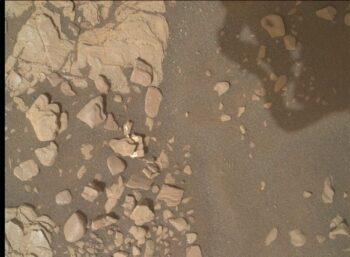
Curiosity Mars Hand Lens Imager (MAHLI) photo produced on Sol 2864, August 26, 2020.
Credit: NASA/JPL-Caltech/MSSS
Dust devil movie
A recent plan has added both a short and a long Navcam dust devil movie, which take lots of images of the same region over, respectively, a five or 30 minute period.
“These give us the most information about dust devils, such as where they initiate, how they evolve, and how much variety there is in size, dust-content, and duration. Looking at how fast they’re moving and in what direction also tells us about the background wind speed and direction at their location,” Newman explains.
Combining images
Also taken, meteorological measurements with the Rover Environmental Monitoring Station (REMS) throughout each movie, in case the robot images a vortex that’s close enough for scientists to also measure its pressure drop, impact on local temperatures, or even ultraviolet radiation if it’s dusty enough to partially block out the Sun.

Curiosity Mars Hand Lens Imager (MAHLI) photo produced on Sol 2864, August 26, 2020.
Credit: NASA/JPL-Caltech/MSSS
“Combining imaging with other observations can tell us more about the size and dust content of a dust devil and how far it is from us,” Newman points out. “We also added a five-minute Navcam dust devil survey. This takes three images in eight directions, covering the whole 360° around the rover, and helps us gather statistics on when and where dust devils occur.”
Not in position
Also continuing is exploration of the clay-bearing unit, where the primary goal at present is to drill and sample material for SAM’s “wet chemistry” experiment. This involves transforming less volatile organics into forms that can be detected using the Sample Analysis at Mars (SAM) Gas Chromatograph Mass Spectrometer.
Newman notes that it turned out that the robot was not positioned perfectly to drill at the “Mary Anning 2” target, so the rover is slated to take a short drive or “bump” to put it in the right place by the next plan.
Regional dust activity
In the meantime, added to the plan were three ChemCam observations of the nodular layers in the “Howwood,” “Maligar,” and “North Fearns” targets, plus a Mastcam image to document those targets. Also added was a ChemCam Remote Micro-Imager (RMI) long-distance mosaic and a Mastcam workspace image.
Finally, the plan included usual Radiation Assessment Detector (RAD) and Dynamic Albedo of Neutrons (DAN) passive and active measurements, and REMS cadence of observations, plus cloud movies and measurements of how much dust is above the robot and across the crater.
“The dust measurements will help us to track the regional dust activity on Mars that has been seen from the surface and orbit in recent sols,” Newman concludes.
As always, dates of planned rover activities are subject to change due to a variety of factors related to the Martian environment, communication relays and rover status.
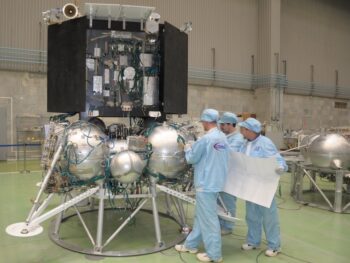
Factory floor integration of science instruments on Russia’s Luna-25 moon mission, being readied for an October 2021 sendoff.
Credit: Roscosmos
There is a multi-country Moon rush in progress. Case in point is NASA orchestrating the Artemis program of robotic and human lunar exploration. Then there’s China, preparing this year to hurl a go-getting return sample mission to the Moon, joining still-active Chinese lander/rover machinery on the lunar farside. Other nations, such as Japan and India, including private firms, have cross-hairs on future lunar exploration.
Now, enter a new “old-timer” that’s joining the celestial fray.

Soviet Union’s Luna-3 snapped this first image of the Moon’s farside in 1959, one of a number of the country’s space race firsts in exploring Earth’s celestial neighbor.
Credit: NASA
Russian re-build
Russia is rebuilding a multi-pronged return to the Moon program, one that kick-starts a 21st century round of outreach to Earth’s extraterrestrial neighbor.
But as Russian space scientists script a “this then that” plan to reconnect with the Moon, how best to gauge their chances of revitalizing a lunar look-see agenda?
For more information, go to my new Scientific American story:
Luna-25 Lander Renews Russian Moon Rush
The former front-runner in the lunar space race aims to rekindle its exploration after nearly half a century
https://www.scientificamerican.com/article/luna-25-lander-renews-russian-moon-rush/
Extraterrestrials by Wade Roush; The MIT Press Essential Knowledge series; Cambridge, Massachusetts; 224 pages; published April 2020; $15.95.
This is an engaging and an excellent tutorial on life elsewhere – always anchored in that are we alone in the universe, and if we are not, where are they?
Containing 5 chapters, the book is very straightforward in its details: “Alien Dreams”; “Making SETI into Science”; “Extremophiles and Exoplanets”; “Answering Fermi”; and “Joining the Conversation.”
“Why the search connects us to the cosmos,” is the one driver of this volume, explains Roush, a freelance science and technology writer, columnist at Scientific American, and host and producer of the tech-and-culture podcast Soonish.
For starters, as one subtitle explains, we need to organize our ignorance.
So where is everybody? The author dives in on that Fermi Paradox with a first-rate number of scenarios, from the Drake equation to intelligent life is rare to the possibility that technological civilizations are uncommunicative.
If they are “out there” how best to prepare for contact? Roush responds by saying “let’s not spend too much time speculating about an inherently unknowable event.” But he suggests, prior to potential contact, we Earthlings should ask ourselves what we would contribute to an interstellar society and what we should do to prepare for that occasion.
This nicely written, reader-friendly book ends with a glossary of terms and a very useful notes section for the entire volume.
Again, this is an easy-to-read 101-explanation of the mind-bending excursion to contemplate the often asked, are we alone question…or perhaps start grappling with just how crowded is it in the universe.
For more information on this book, go to:
https://mitpress.mit.edu/books/extraterrestrials
Also, go to “Life as We Don’t Know It – If we’re going to find extraterrestrials, we need to stop assuming they’ll think like humans,” by Wade Roush at:
https://blogs.scientificamerican.com/observations/life-as-we-dont-know-it/
as well as a podcast featuring Roush at:
https://mitpress.podbean.com/e/extraterrestrials-with-wade-roush/
The lander and rover of China’s Chang’e-4 lunar farside mission have resumed operations for the 21st lunar day. A lunar day is equal to 14 days on Earth, and a lunar night is the same length.
Chinese news groups note that the lander woke up at 14:54 Thursday (Beijing Time) while the rover awoke at 20:34 Wednesday. Both are in normal working order, according to the Lunar Exploration and Space Program Center of the China National Space Administration (CNSA).
The Chang’e-4 mission was launched on December 8, 2018. It made the first-ever soft landing on the Von Kármán crater in the South Pole-Aitken Basin on the farside of the Moon on January 3, 2019.
The Yutu-2 rover will continue to move northwest toward the basalt area or the impact craters with high reflectivity, according to the center.
Ambitious venture
If all goes according to plan, China is preparing the Chang’e-5 lunar mission by year’s end. This ambitious venture is focused on collecting and returning lunar specimens back to Earth by robotic means – a task last done in 1976 by the former Soviet Union.

Soviet Union’s last Moon sample mission, Luna 24 sits on the edge of a 60 meter diameter crater. Photo taken by NASA’s
Lunar Reconnaissance Orbiter Camera, or LROC.
Credit: NASA/GSFC/Arizona State University
The former Soviet Union successfully executed three robotic sample return missions: Luna 16 returned a small sample (101 grams) from Mare Fecunditatis in September of 1970; February 1972, Luna 20 returned 55 grams of soil from the Apollonius highlands region; Luna 24 retrieved 170.1 grams of lunar samples from the Moon’s Mare Crisium (Sea of Crisis) for return to Earth in August 1976.

China plans to launch the ambitious Chang’e 5 lunar sample return mission later this year. (Image credit: Used with permission: Loren Roberts/The Planetary Society at https://www.planetary.org/)
Apollo-like architecture
Reportedly, the Chinese mission will retrieve and return to Earth up to 4.4 pounds (2 kilograms) of lunar surface and subsurface samples.
The Chang’e-5 mission is comprised of four parts: the orbiter, lander, ascender, and Earth reentry module containing the lunar collectibles.
In many ways, but on a smaller scale, Chang’e-5’s step-by-step trek mirror those of the Apollo human landing program architecture– suggesting a scalable approach to planting Chinese footprints on the Moon.
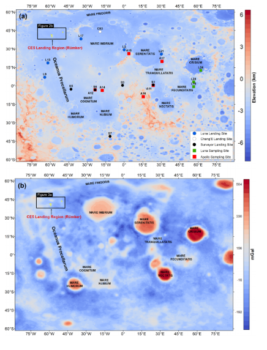
Location of the Rümker region (black box). Yellow star represents the proposedChang’e-5 candidate landing sites.
Credit: Chikondi Chisenga, et. al
Landing region
The reported preferred candidate landing region for China’s Chang’e‐5 lunar sample return mission is the Rümker region, located in the northern Oceanus Procellarum. The touchdown area is geologically complex and known for its volcanic activity.
Detailed study of the Chang’e-5 landing region has narrowed down to four potential candidate landing sites within that region that would maximize the scientific return of the mission.
If successful, China would become the third nation to grab, stash, and haul back to Earth select lunar samples.
Welcome to the crowded and cluttered space skies above Earth…congested, contested, competitive, inspected, and dejected.
Orbiting riff-raff continues be a daunting problem – with a new study released on August 20 focused on space traffic management, or STM for short.
Space Traffic Management: Assessment of the Feasibility, Expected Effectiveness, and Funding Implications of a Transfer of Space Traffic Management – has been issued by the National Academy of Public Administration (NAPA).

In-orbit explosions can be related to the mixing of residual fuel that remain in tanks or fuel lines once a rocket stage or satellite is discarded in Earth orbit. The resulting explosion can destroy the object and spread its mass across numerous fragments with a wide spectrum of masses and imparted speeds.
Credit: ESA
Complex issues
“There is general agreement within the space community on actions that can address the complex underlying space traffic management issues facing the world of stakeholders deploying orbital assets. However, there are questions regarding where the responsibility for space traffic management should ultimately reside,” explains NAPA’s Teresa W. Gerton, President and Chief Executive Officer in a foreword to the report.
And the winner is…
The NAPA appraisal focused on four agency candidates “best suited” to take on the STM task: (1) the Office of Space Commerce (OSC), a part of National Oceanic and Atmospheric Administration (NOAA) inside the Department of Commerce (DOC); (2) Office of Commercial Space Transportation (AST), part of the Federal Aviation Administration (FAA) inside the Department of Transportation (DOT); (3) NASA; or (4) the Department of Defense (DoD).
The NAPA report utilized an evaluative criteria with an expert panel determining that the Office of Space Commerce (OSC) — a part of the National Oceanic and Atmospheric Administration (NOAA) inside the Department of Commerce – is “best suited” to perform STM tasks within the federal government.
Other agencies must continue to work collaboratively now, and in the future, to achieve a safer space domain, the NAPA study explains.
Actionable safety data
“The report contains a lot of good information about why Space Traffic Management (STM) matters, and why it is important for Congress to designate a Lead Agency for STM,” said George Nield, formerly the Associate Administrator for Commercial Space Transportation from 2008-2018. He is President of Commercial Space Technologies, LLC, which was founded to encourage, facilitate, and promote commercial space activities.
“In my opinion, the primary responsibility of the Lead Agency will be to develop a system that can provide timely and actionable safety data to all space operators,” Nield told Inside Outer Space. “The report doesn’t describe in detail how the Department of Commerce (DOC) would accomplish that, so Congress may have some questions for them along those lines.”
According to the report, Nield flags the fact that “OSC [the Office of Space Commerce] views its STM responsibilities as a data management function, rather than principally as a task of managing space traffic.” The report goes on to say that “OSC must find ways to leverage DoD [Department of Defense] data and capabilities.”
“Having access to DoD data and capabilities will certainly be helpful, but it will be crucial for DOC to collect and incorporate additional observations, and to use them to improve the quality of the products and services it provides,” Nield adds. “After all, it is important to recognize that the current DoD system no longer meets the needs of the user community in terms of completeness of the data, accuracy of the catalog, timeliness of the information, and the excessive number of false alarms.”
Deploy fewer satellites
“I believe that space debris is a serious problem. But it is not a disaster, nor will it ever render space unusable or cascade into oblivion. Proving this is straightforward and irrefutable,” suggests Dave Finkleman, a member of the International Academy of Astronautics (IAA) Permanent Committee on Space Debris and other expert communities.
“But a community has grown that relies on debris funding. They continuously cite the Kessler Syndrome [a theoretical, self-sustaining cascading collision of space debris in low Earth orbit]. Deploying fewer satellites is the only assured approach to minimizing debris,” says Finkleman.
Mission impacts and cost
“Space traffic cannot be managed. No regulatory authority can force an operator to move his satellite, even if that operator is within its jurisdiction. Although many maneuvers consume little energy, there will be mission impacts and cost. Conjunction avoidance is notoriously and perhaps irretrievably imprecise and unreliable. The Air Force wishes not to be blamed for the consequences of the deficiencies,” Finkleman says.
Finkleman’s bottom line: “DoC does not have the skills for traffic management.”
Note: To read the full report — Space Traffic Management: Assessment of the Feasibility, Expected Effectiveness, and Funding Implications of a Transfer of Space Traffic Management — go to:
https://www.napawash.org/uploads/NAPA_OSC_Final_Report.pdf
Also, go to “The Dilemma of Space Debris,” by Dave Finkleman at:
https://www.americanscientist.org/article/the-dilemma-of-space-debris




